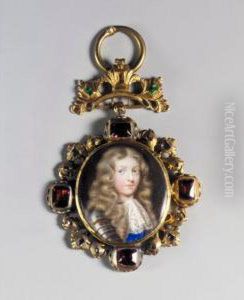Jean Ii Petitot Paintings
Jean Petitot II, born in 1607 in Geneva, was an eminent enamel painter, particularly renowned for his exquisite portrait miniatures. He was the son of Faulle Petitot, a wood-carver, and inherited his artistic inclinations from his family, which included several goldsmiths and enamelers.
Petitot initially trained as a jeweler and goldsmith in his hometown before moving to France to further his skills. In Paris, he studied painting under the guidance of Simon Vouet, a leading French Baroque painter. It was during this time that Petitot began to specialize in the art of enameling.
His talents quickly gained recognition, and he was invited to the court of King Charles I in England, where he worked with another famed miniaturist, Nicholas Hilliard. However, Petitot's most significant career development came with his service to Louis XIV of France. At the French court, Petitot collaborated with the portrait painter, Charles Le Brun. Together, they created a series of portraits of the king, the royal family, and members of the court. These works were celebrated for their vivid colors and meticulous detail, qualities that became the hallmark of Petitot's style.
Petitot's enamels were highly sought after and collected by the European aristocracy and gentry, who valued them not only as personal adornments but also as objects of art. His technique involved applying enamel to a gold base in multiple thin layers, which were then fired at high temperatures. The result was a lustrous and durable finish that preserved the luminosity of the colors.
Jean Petitot II continued his craft well into his old age, contributing significantly to the art of enamel painting and setting standards that would inspire generations of enamelists. He died in 1691, leaving behind a legacy of artistic excellence that solidified his place as one of the most distinguished enamel painters of the 17th century.
